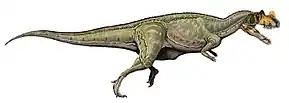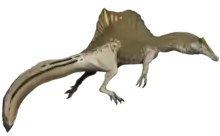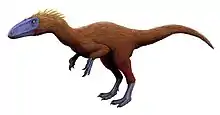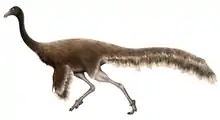Calamospondylus
Calamospondylus (meaning "quill vertebrae") is a genus of theropod dinosaur. It lived during the Early Cretaceous, and its fossils were found on the Isle of Wight in southern England.
| Calamospondylus | |
|---|---|
| Scientific classification | |
| Kingdom: | Animalia |
| Phylum: | Chordata |
| Clade: | Dinosauria |
| Clade: | Saurischia |
| Clade: | Theropoda |
| Clade: | Pennaraptora |
| Clade: | †Oviraptorosauria |
| Genus: | †Calamospondylus Fox, 1866 |
| Species: | †C. oweni |
| Binomial name | |
| †Calamospondylus oweni Fox, 1866 | |
Taxonomy
The type species, Calamospondylus oweni, was described anonymously by amateur paleontologist William D. Fox in 1866 on the basis of a sacrum and associated pelvic elements found on the Isle of Wight in the layers of the Wessex Formation.[1] Several authors (e.g. Woodward & Sherborn 1890; Swinton 1936; Steel 1970) regarded Calamospondylus as a nomen nudum for Aristosuchus and therefore based on the same specimen as the Aristosuchus holotype.[2][3][4] However, as noted by Naish (2002), size discrepancies between the holotypes of Calamospondylus oweni and Aristosuchus pusillus as well as letters of correspondence between Richard Owen and Reverend William Fox demonstrate that C. oweni is based on a different specimen than Aristosuchus.[5][6]
See also
References
- Anonymous (Fox, W.) (1866). "Another new Wealden reptile." The Athenaeum, 2014: 740.
- A. S. Woodward and C. D. Sherborn. 1890. A Catalogue of British Fossil Vertebrata. Dulao & Company, London 1-396.
- Swinton, W.E. 1936. The dinosaurs of the Isle of Wight. Proceedings of the Geologists’ Association, 47, 204–220.
- Steel, R. 1970. Encyclopedia of Paleoherpetology, Part 14: Saurischia. Gustav Fischer Verlag, Stuttgart.
- Naish, D. (2002). The historical taxonomy of the Lower Cretaceous theropods (Dinosauria) Calamospondylus and Aristosuchus from the Isle of Wight. Proceedings of the Geologists' Association 113: 153-163.
- Naish, D. 2011. Theropod dinosaurs. In Batten, D. J. (ed.) English Wealden Fossils. The Palaeontological Association (London), pp. 526–559.













